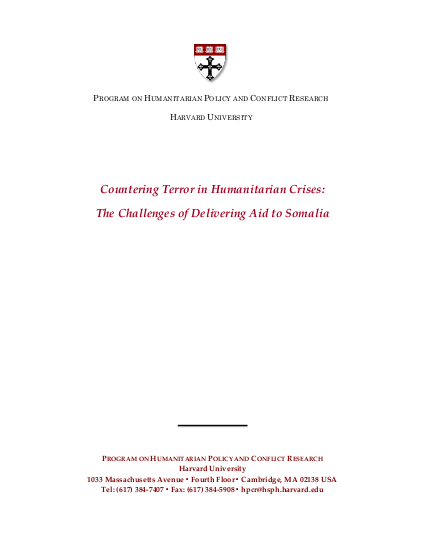
In the post---9/11 era, humanitarian organizations face a growing dilemma regarding access to vulnerable groups in internal conflicts. On the one hand, international actors have increasingly recognized the importance of engaging with non---state armed groups (NSAGs) to ensure the timely delivery of humanitarian assistance in crisis---affected territories. On the other hand, in recent years, political and policy actors operating at domestic, regional, and international levels have pursued security policies and enacted laws geared toward curbing relationships with NSAGs accused of executing acts of terrorism. As a result of these two parallel developments, humanitarian actors are often uncertain about how to implement aid initiatives based on international legal standards while maintaining adherence to national laws.1 This dilemma is particularly acute in Somalia. Harakat al---Shabaab al---Mujahideen, or the Shabaab (“the youth” in Arabic), is an al Qaeda affiliate that controls vast swaths of territory in southern and central Somalia. The group has required humanitarian actors, among other measures, to pay fees to deliver humanitarian aid to populations located in territories controlled by the Shabaab. But the United Nations Security Council (UNSC), regional organizations, and individual states — including the United States, the United Kingdom, Australia, and Canada — have undertaken a series of coordinated actions geared toward isolating and criminalizing engagement with the Shabaab. The resulting counterterrorism legal framework has left humanitarian organizations with a predicament: engaging with and potentially paying fees to the Shabaab may be necessary for delivering lifesaving assistance to tens of thousands of civilians but may also engender criminal liability. In light of the famine that began in 2011, a situation that the United Nations High Commissioner for Refugees (UNHCR) dubbed the “worst humanitarian crisis in the world,”2 the situation in Somalia has been particularly grim, and the potential consequences of this unresolved dilemma to crisis---affected civilians particularly adverse. This paper examines the challenges that result from this quandary. Part I offers an overview of the historical context of Somalia’s ongoing humanitarian crisis. Part II describes the legal basis for humanitarian initiatives in Somalia, focusing on tensions between different bodies of law that have led humanitarian actors to perceive a lack of legal clarity. Part III details key challenges — either caused by or compounded by this legal confusion — of delivering humanitarian aid in Somalia. And Part IV explores avenues that humanitarian organizations and governments might consider moving forward.
